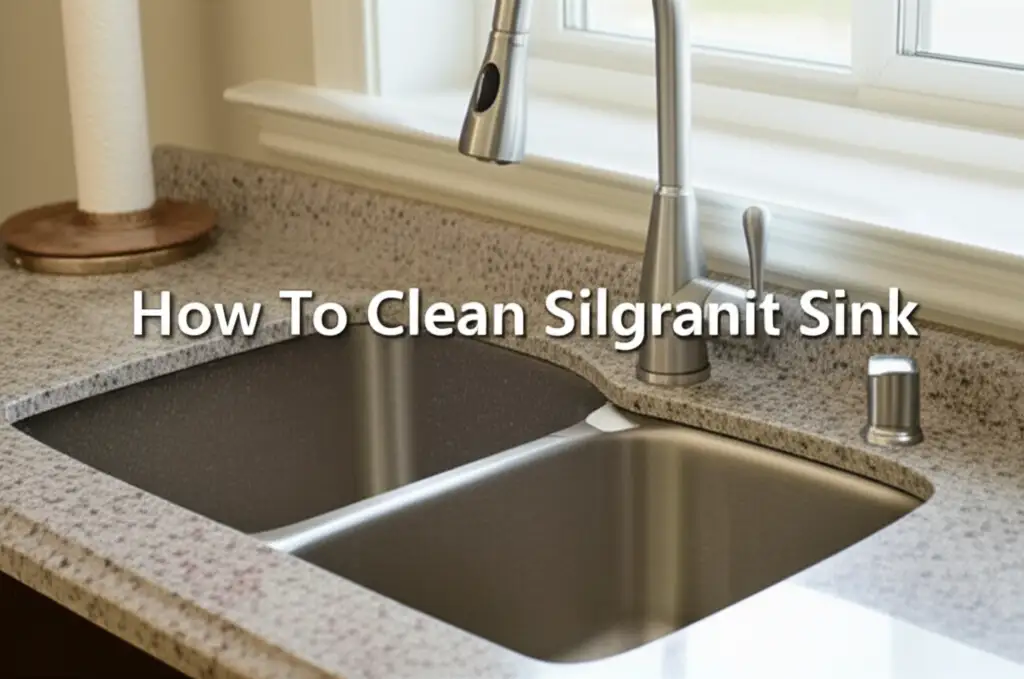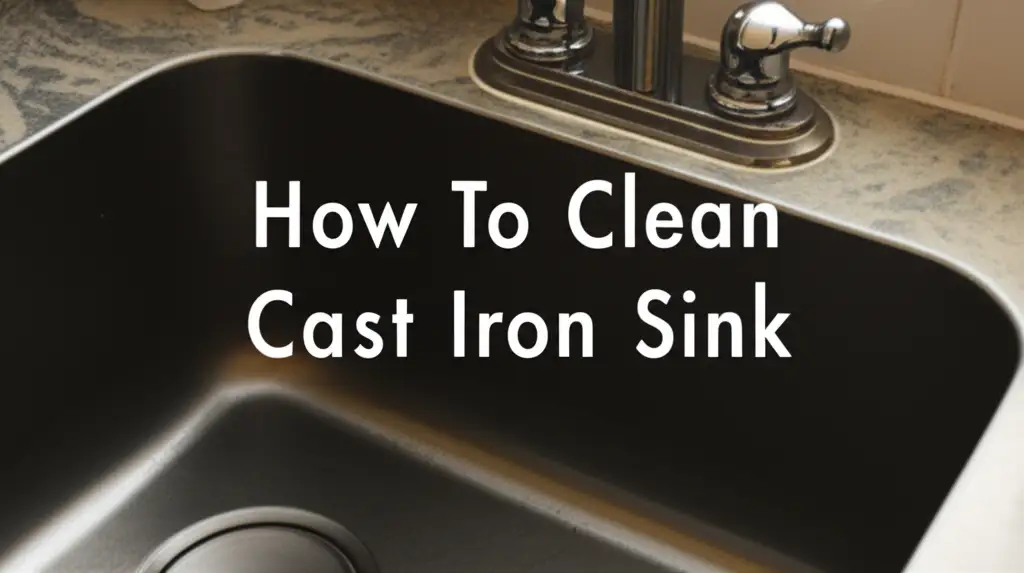· Kitchen Maintenance · 13 min read
How To Clean Silgranit Sink

Keep Your Silgranit Sink Spotless: A Complete Cleaning Guide
Your kitchen sink works hard. It handles dirty dishes, food scraps, and daily wear. If you own a Silgranit sink, you know its unique beauty and durability. These sinks, made from a special granite composite, offer a distinct look and feel. However, they need specific cleaning methods to keep them looking their best.
I want to help you learn exactly how to clean a Silgranit sink. This guide covers everything from daily upkeep to removing tough stains. You will understand the right products to use and the ones to avoid. My aim is to help you maintain your Silgranit sink’s appearance for years. You will find simple steps for daily care and detailed plans for deeper cleaning.
Takeaway:
- Wipe your Silgranit sink daily to stop hard water spots.
- Use gentle cleaners like dish soap for routine care.
- Baking soda and vinegar handle most common stains.
- Avoid strong chemicals or abrasive tools to protect the surface.
How do you clean a Silgranit sink?
To clean a Silgranit sink, use mild dish soap and warm water for daily maintenance, wiping it dry after each use to prevent water spots. For tougher stains, create a paste using baking soda and water, apply it, allow it to sit briefly, then gently scrub. Rinse the sink completely. Do not use abrasive scrubbers or strong chemicals, as these can harm the sink’s surface.
Understanding Your Silgranit Sink: Why Special Care Matters
Silgranit sinks are a popular choice for many kitchens. These sinks are a type of granite composite. They combine natural granite with high-quality acrylic resins. This blend creates a material that resists heat, scratches, and impacts. It also offers a beautiful, stone-like appearance. Many people choose Silgranit for its durability and aesthetic appeal.
Despite its strength, Silgranit needs specific care. The surface is non-porous, which makes it hygienic and stain-resistant. However, hard water, certain foods, or harsh cleaners can still affect its finish. Over time, mineral deposits can build up, leading to discoloration. Using the wrong cleaning products can dull the sink’s natural luster or even damage its protective layer. Proper cleaning helps keep the surface intact. It stops problems like fading or texture changes.
Think of your Silgranit sink as an investment. Taking care of it means keeping its look and function over many years. Regular cleaning helps prevent issues before they become big problems. I always advise understanding the material you work with. This knowledge makes cleaning much more effective. It also ensures you use safe methods for your sink.
Daily Habits for a Clean Silgranit Sink
Daily cleaning is the most important step for a beautiful Silgranit sink. A simple routine can prevent most common problems. It stops stains and hard water spots from setting in. I always tell people that prevention is easier than cure. This is very true for sink care. Make these steps part of your kitchen cleanup.
Start by rinsing your sink thoroughly after each use. Wash away any food particles or spills. Use warm water for this. This step stops residue from drying onto the surface. Next, apply a few drops of mild dish soap to a soft cloth or sponge. Wipe down the entire sink basin. Make sure to clean the sides and bottom. You can also clean your faucet at this time to keep the whole area sparkling. Find more tips on cleaning kitchen fixtures here: how to clean sink faucet.
After wiping with soap, rinse the sink again with clean water. This removes all soap residue. The final, and crucial, step is to dry the sink. Use a clean, soft towel for this. Drying the sink stops hard water spots. These spots contain minerals that can leave white marks. Over time, these marks become very hard to remove. A quick wipe-down takes only seconds. It saves you much more time later on. Consistency makes a big difference.
Effective Methods for Removing Common Silgranit Sink Stains
Even with daily care, some stains might appear. Silgranit sinks are stain-resistant, but they are not stain-proof. Certain foods, liquids, or prolonged contact can leave marks. Do not worry. Most common stains respond well to simple cleaning solutions. I find these methods work best for my own sink.
Dealing with Food and Coffee Stains
Food and coffee are frequent culprits for sink stains. These organic materials can leave dark marks, especially on lighter-colored sinks. You can remove them with a simple paste. Mix baking soda with a little water. Create a thick paste. Apply this paste directly onto the stain. Let it sit for about 15-30 minutes. The baking soda works to lift the stain.
After the paste sits, gently scrub the area. Use a soft brush or a non-abrasive sponge. Avoid anything harsh that might scratch the sink. Rinse the sink thoroughly with warm water. You might need to repeat this process for stubborn stains. This method is safe for your Silgranit surface.
Tackling Hard Water and Mineral Deposits
Hard water stains look like white, chalky residue. These deposits come from minerals in your tap water. They are common in areas with hard water. Vinegar is an excellent natural solution for these stains. Mix equal parts white vinegar and water in a spray bottle. Spray the solution generously over the affected areas. Let it sit for about 30 minutes to an hour.
For very tough hard water buildup, you can soak paper towels in the vinegar solution. Lay the soaked paper towels directly onto the stains. This keeps the vinegar in contact with the minerals longer. Gently scrub with a soft brush or sponge. Rinse thoroughly afterward. This process works wonders for dissolving mineral buildup. You can also use vinegar to clean your sink drain, as explained here: how to clean sink drain with vinegar.
Removing Stubborn Oil and Grease
Grease and oil can leave a sticky film or dark spots. These stains are often from cooking. For these, a degreasing dish soap works well. Apply a small amount of concentrated dish soap directly to the greasy area. Use hot water and a soft cloth to scrub. The hot water helps break down the grease.
Rinse the sink well after scrubbing. If the grease is very thick, you might need to repeat this. A paste of baking soda and a few drops of dish soap can also help. Apply it, let it sit, then scrub. Always ensure you rinse away all soap residue to prevent a dull film from forming.
Deep Cleaning Your Silgranit Sink for Lasting Beauty
Regular daily cleaning keeps your Silgranit sink tidy. However, every now and then, your sink needs a deeper clean. This helps remove any accumulated grime or very stubborn stains. I recommend a deep clean at least once a month. This schedule keeps your sink looking its best over time.
Start by completely emptying your sink. Remove any dish racks or grids. Give the sink a good initial rinse with warm water. This washes away loose debris. For a thorough deep clean, you have a few options. Many people use a commercial cleaner specifically designed for granite composite sinks. If you choose this path, always read the product instructions carefully. These cleaners are formulated to be safe for your sink material. They can often restore shine.
Another effective method involves a mild bleach solution for very tough stains or discoloration. Mix one part bleach with ten parts water. This is a very diluted solution. Apply it to the stained areas. Let it sit for a short period, about 10-15 minutes. Watch the sink closely during this time. Do not use undiluted bleach. It can harm the finish. Bleach works on some organic stains. Always rinse the sink completely with plenty of water after using any bleach. Make sure no residue remains. This is vital.
For a deeper clean on granite composite sinks, you might find more comprehensive instructions. You can look at how to clean other types of composite sinks for comparison. More information is available on how to clean a composite sink. The principles are similar: how to clean composite sink. A deep clean ensures your Silgranit sink maintains its appeal and hygiene.
Protecting Your Silgranit Sink: What to Avoid and Best Practices
Knowing how to clean your Silgranit sink is important. Knowing what not to do is equally vital. Certain substances and habits can damage your sink’s surface. Preventing damage is simpler than repairing it. I always emphasize protecting your sink.
Harsh Chemicals and Abrasive Cleaners
The biggest threat to your Silgranit sink is harsh chemicals. Avoid using strong acids, alkalis, or undiluted bleach. Drain cleaners, oven cleaners, and paint removers are also very harmful. These products can etch the surface or cause permanent discoloration. They can break down the resin that binds the granite particles. This leads to a dull finish or rough texture.
Also, stay away from abrasive cleaning tools. Steel wool, wire brushes, and scouring pads can scratch the surface. While Silgranit is scratch-resistant, these tools can still leave marks. Use soft cloths, sponges, or nylon brushes instead. This keeps the sink’s smooth finish intact.
Preventing Scratches and Heat Damage
Silgranit is tough, but it is not indestructible. Dropping heavy items can cause chips or cracks. Use a sink grid if you often drop dishes. Cutting directly in your sink is also a bad idea. Always use a cutting board. This protects both your knives and your sink.
Silgranit handles high temperatures, but extreme heat changes can be harmful. Avoid placing hot pots or pans directly from the stove onto the sink surface. Use a trivet or allow them to cool slightly. Sudden temperature shocks can stress the material over time. This can lead to small cracks.
Long-Term Maintenance Tips
Consistency helps a lot. Wipe down your sink after each use. This prevents everyday buildup. For a lasting shine, some people apply a small amount of mineral oil. After cleaning and drying the sink, put a few drops of mineral oil on a paper towel. Rub it into the sink surface. Buff it gently with a clean cloth. This can enhance the color and create a subtle sheen. It also helps repel water.
Promptly clean up spills, especially from staining foods like beet juice or coffee. The faster you clean, the less chance a stain has to set. Black Silgranit sinks, like other dark-colored sinks, show hard water spots more easily. Daily drying is especially important for them. You can find more tips on how to keep dark sinks looking good here: how to clean black kitchen sink. These simple steps ensure your Silgranit sink remains a beautiful and functional part of your kitchen for years.
Restoring Shine and Tackling Tough Discoloration
Sometimes, even with good care, a Silgranit sink might lose some of its original luster. It might appear dull or develop persistent discoloration. This often happens due to hard water buildup or accumulated grime that regular cleaning missed. Do not worry. You can often restore your sink’s beauty.
For dullness, a simple trick is to use mineral oil. As mentioned before, after your sink is clean and dry, apply a small amount of mineral oil. Rub it in evenly with a soft cloth. Then, buff it off with a dry, clean cloth. This step moisturizes the surface and helps bring out the rich color. It creates a nice, subtle shine. I do this regularly for my dark-colored sinks.
If you have tough discoloration, especially from strong stains or neglected hard water, you might need a stronger approach. Some specialized composite sink cleaners are available. These cleaners are designed to restore the original finish. Always follow the product directions exactly. They might contain mild abrasives or chemicals. Make sure the product is safe for Silgranit.
Another option for stubborn white haziness from hard water is a calcium, lime, and rust (CLR) remover. Apply it carefully. Dilute it if the product recommends it. Do not leave it on for too long. Always test a small, hidden area first. Rinse very thoroughly after using such products. If your sink has deep scratches or significant damage, professional resurfacing might be an option. However, for most common dullness or discoloration, home methods work well. Keep trying and stay consistent. Your Silgranit sink can look great again.
Frequently Asked Questions About Cleaning Silgranit Sinks
1. Can I use bleach on my Silgranit sink?
You can use a very diluted bleach solution on a Silgranit sink for tough stains, but use it with extreme caution. Mix one part bleach with ten parts water. Apply it only to the stained area for a short time, about 10-15 minutes. Undiluted bleach can damage the surface and cause discoloration. Always rinse the sink thoroughly with plenty of water immediately after using bleach.
2. How do I remove hard water stains from Silgranit?
To remove hard water stains from your Silgranit sink, use white vinegar. Mix equal parts white vinegar and water in a spray bottle. Spray the solution onto the stains and let it sit for 30 minutes to an hour. For severe buildup, soak paper towels in the solution and place them on the stains. Scrub gently with a soft brush, then rinse completely.
3. My black Silgranit sink looks dull. How can I make it shiny again?
Black Silgranit sinks can look dull due to hard water or detergent residue. After cleaning and drying your sink, apply a small amount of mineral oil with a soft cloth. Rub it in evenly. Buff the surface with a clean, dry cloth. This will enhance the color and create a subtle sheen, making your black sink look more vibrant.
4. What is the best daily cleaner for a Silgranit sink?
The best daily cleaner for a Silgranit sink is mild dish soap and warm water. After each use, rinse the sink and wipe it down with a soft cloth and a few drops of dish soap. Always dry the sink thoroughly with a clean towel afterward. This simple routine prevents hard water spots and keeps the sink clean.
5. Can I use abrasive scrubbers on Silgranit?
No, you should not use abrasive scrubbers on Silgranit sinks. Steel wool, wire brushes, or harsh scouring pads can scratch or damage the sink’s surface. Even though Silgranit is durable, these tools can dull its finish or create permanent marks. Always use soft cloths, sponges, or nylon brushes for cleaning.
6. How often should I deep clean my Silgranit sink?
You should deep clean your Silgranit sink at least once a month. This frequency helps remove any accumulated grime or stubborn stains that daily cleaning might miss. If your sink gets heavy use or you live in an area with very hard water, you might consider deep cleaning more often, perhaps every two weeks.
Conclusion
Keeping your Silgranit sink clean and beautiful is simple when you know the right steps. We have covered everything you need to know. From daily wipe-downs to tackling tough stains, you now have a complete guide. Remember, consistent daily care makes the biggest difference. It prevents most problems before they start. Use mild soap for regular cleaning. Reach for baking soda and vinegar for common stains. Always avoid harsh chemicals and abrasive tools.
Properly cleaning your Silgranit sink helps it last longer. It maintains its stunning appearance for many years. A well-cared-for sink improves your kitchen’s overall look. I encourage you to put these tips into practice. You will love how your Silgranit sink shines. Do you have your own special tips for keeping a Silgranit sink spotless? Share your wisdom with us. Explore other cleaning guides on our site for more ways to keep your home sparkling.
- Silgranit cleaning
- granite composite
- sink care
- stain removal
- kitchen sink




